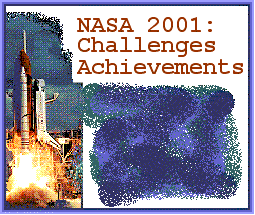 |
NASA 2001:
Notable science and engineering marvels muted by tragic events of September 11 |
| NASA leadership change. Flags for heroes and families. Mars Odyssey arrives while Global Surveyor works. Search for universal live. Remote sensing Earth's climate change. GPS satellites assist farmers and in disasters. Research stops light and aids biomedicine. Deep Space 1 visits comet while NEAR lands on asteroid. Shuttle 20th anniversary during space station year of habitation. Next-generation shuttle, synthetic vision, Helios. | |
|---|---|
